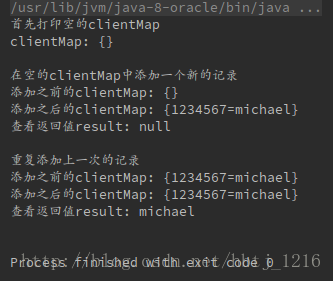您好,登录后才能下订单哦!
小编给大家分享一下java中ConcurrentMap.putIfAbsent(key,value)怎么用,希望大家阅读完这篇文章之后都有所收获,下面让我们一起去探讨吧!
业务上经常会遇到有这种场景,全局维护一个并发的ConcurrentMap, Map的每个Key对应一个对象,这个对象需要只创建一次。如果Map中该key对应的value不存在则创建,否则直接返回。
我们先看一下代码:
public static Locale getInstance(String language, String country,
String variant) {
//...
String key = some_string;
Locale locale = map.get(key);
if (locale == null) {
locale = new Locale(language, country, variant);
map.put(key, locale);
}
return locale;
}这段代码要做的事情是:
调用 map.get(key) 方法,判断 map 里面是否有该 key 对应的 value (Locale 对象)。
如果返回 null,表示 map 里面没有要查找的 key-value mapping。new 一个 Locale 对象,并把 new 出来的这个对象与 key 一起放入 map。
最后返回新创建的 Locale 对象
我们期望每次调用 getInstance 方法时要保证相同的 key 返回同一个 Local 对象引用。这段代码能实现这个需求吗?
答案是:在单线程环境下可以满足要求,但是在多线程环境下会存在线程安全性问题,即不能保证在并发的情况相同的 key 返回同一个 Local 对象引用。
这是因为在上面的代码里存在一个习惯被称为 put-if-absent 的操作 [1],而这个操作存在一个 race condition:
if (locale == null) {
locale = new Locale(language, country, variant);
map.put(key, locale);
}因为在某个线程做完 locale == null 的判断到真正向 map 里面 put 值这段时间,其他线程可能已经往 map 做了 put 操作,这样再做 put 操作时,同一个 key 对应的 locale 对象被覆盖掉,最终 getInstance 方法返回的同一个 key 的 locale 引用就会出现不一致的情形。所以对 Map 的 put-if-absent 操作是不安全的(thread safty)。
为了解决这个问题,java 5.0 引入了 ConcurrentMap 接口,在这个接口里面 put-if-absent 操作以原子性方法 putIfAbsent(K key, V value) 的形式存在。正如 javadoc 写的那样:
putIfAbsent方法主要是在向ConcurrentHashMap中添加键—值对的时候,它会先判断该键值对是否已经存在。
如果不存在(新的entry),那么会向map中添加该键值对,并返回null。
如果已经存在,那么不会覆盖已有的值,直接返回已经存在的值。
对上面方法进行改造:
public static Locale getInstance(String language, String country,
String variant) {
//...
String key = some_string;
Locale locale = map.get(key);
if (locale == null) {
locale = new Locale(language, country, variant);
map.putIfAbsent(key, locale);
}
return locale;
}这段代码使用了 Map 的 concurrent 形式(ConcurrentMap、ConcurrentHashMap),并简单的使用了语句map.putIfAbsent(key, locale) 。这同样不能保证相同的 key 返回同一个 Locale 对象引用。
这里的错误出在忽视了 putIfAbsent 方法是有返回值的,并且返回值很重要。
所以,使用 putIfAbsent 方法时切记要对返回值进行判断。
public static Locale getInstance(String language, String country,
String variant) {
//...
String key = some_string;
Locale locale = map.get(key);
if (locale == null) {
locale = new Locale(language, country, variant);
Locale tmp = map.putIfAbsent(key, locale);
if (tmp != null) {
locale = tmp;
}
}
return locale;
}import java.util.Map;
import java.util.concurrent.ConcurrentHashMap;
public class Test {
public static void main(String[] args) {
//测试一下currentHashMap.putIfAbsent()
Map<long, String> clientMap = new ConcurrentHashMap<>();
System.out.println("首先打印空的clientMap");
System.out.println("clientMap: " + clientMap);
System.out.println();
//在空的clientMap中添加一个新的记录
System.out.println("在空的clientMap中添加一个新的记录");
System.out.println("添加之前的clientMap: " + clientMap);
long netId = 1234567L;
String str1 = "michael";
String result = clientMap.putIfAbsent(netId, str1);
System.out.println("添加之后的clientMap: " + clientMap);
System.out.println("查看返回值result: " + result);
System.out.println();
//重复添加
System.out.println("重复添加上一次的记录");
System.out.println("添加之前的clientMap: " + clientMap);
String result2 = clientMap.putIfAbsent(netId, str1);
System.out.println("添加之后的clientMap: " + clientMap);
System.out.println("查看返回值result: " + result2);
System.out.println();
}
}
看完了这篇文章,相信你对“java中ConcurrentMap.putIfAbsent(key,value)怎么用”有了一定的了解,如果想了解更多相关知识,欢迎关注亿速云行业资讯频道,感谢各位的阅读!
免责声明:本站发布的内容(图片、视频和文字)以原创、转载和分享为主,文章观点不代表本网站立场,如果涉及侵权请联系站长邮箱:is@yisu.com进行举报,并提供相关证据,一经查实,将立刻删除涉嫌侵权内容。